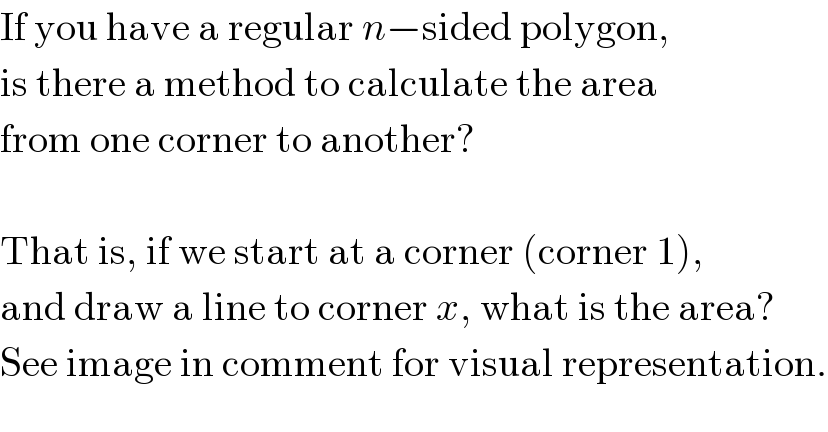
Question Number 5515 by FilupSmith last updated on 17/May/16

$$\mathrm{If}\:\mathrm{you}\:\mathrm{have}\:\mathrm{a}\:\mathrm{regular}\:{n}−\mathrm{sided}\:\mathrm{polygon}, \\ $$$$\mathrm{is}\:\mathrm{there}\:\mathrm{a}\:\mathrm{method}\:\mathrm{to}\:\mathrm{calculate}\:\mathrm{the}\:\mathrm{area} \\ $$$$\mathrm{from}\:\mathrm{one}\:\mathrm{corner}\:\mathrm{to}\:\mathrm{another}? \\ $$$$ \\ $$$$\mathrm{That}\:\mathrm{is},\:\mathrm{if}\:\mathrm{we}\:\mathrm{start}\:\mathrm{at}\:\mathrm{a}\:\mathrm{corner}\:\left(\mathrm{corner}\:\mathrm{1}\right), \\ $$$$\mathrm{and}\:\mathrm{draw}\:\mathrm{a}\:\mathrm{line}\:\mathrm{to}\:\mathrm{corner}\:{x},\:\mathrm{what}\:\mathrm{is}\:\mathrm{the}\:\mathrm{area}? \\ $$$$\mathrm{See}\:\mathrm{image}\:\mathrm{in}\:\mathrm{comment}\:\mathrm{for}\:\mathrm{visual}\:\mathrm{representation}. \\ $$
Commented by FilupSmith last updated on 17/May/16

Answered by Rasheed Soomro last updated on 17/May/16

Commented by Rasheed Soomro last updated on 19/May/16
![Region ABCDE=Region ABCDEO−▲AEO In general, if first corner is A_1 and xth corner (upto wbich area is required and of course 0<x<n for n-gon) is A_x then, Region A_1 A_2 ...A_x =Region A_1 A_2 ...A_x O−▲A_1 A_x O Region A_1 A_2 ...A_n O consists of x−1 isosceles triangles in general (only in hexagon these triangles are equilateral).If polygon is n-gon each of these triangles has ((360)/n) degree angle at centre (O) of polygon and △A_1 A_x O has (x−1)(((360)/n)) dgree angle at O. Let radius of the polygon is r Each triangle in Region A_1 A_2 ...A_x O has area: ▲=(1/2)r^2 sin ((360)/n) Region A_1 A_2 ...A_x O consist of x−1 such triangles So, Region A_1 A_2 ...A_x O=(x−1)×(1/2)r^2 sin ((360)/n) =(1/2)r^2 (x−1) sin ((360)/n) And now ▲A_1 A_x O=(1/2)r^2 sin ((360(x−1))/n) So finally Region A_1 A_2 ...A_x =Region A_1 A_2 ...A_x O−▲A_1 A_x O =(1/2)r^2 (x−1) sin ((360)/n)−(1/2)r^2 sin ((360(x−1))/n) = (1/2)r^2 [(x−1) sin ((360)/n)−sin ((360(x−1))/n)]](Q5527.png)
$$\mathrm{Region}\:\mathrm{ABCDE}=\mathrm{Region}\:\mathrm{ABCDEO}−\blacktriangle\mathrm{AEO} \\ $$$$ \\ $$$$\mathrm{In}\:\mathrm{general},\:\mathrm{if}\:\mathrm{first}\:\mathrm{corner}\:\mathrm{is}\:\mathrm{A}_{\mathrm{1}} \:\mathrm{and}\:\mathrm{xth}\:\mathrm{corner} \\ $$$$\left(\mathrm{upto}\:\mathrm{wbich}\:\mathrm{area}\:\mathrm{is}\:\mathrm{required}\:\mathrm{and}\:\mathrm{of}\:\mathrm{course}\:\right. \\ $$$$\left.\mathrm{0}<\mathrm{x}<\mathrm{n}\:\mathrm{for}\:\mathrm{n}-\mathrm{gon}\right)\:\mathrm{is}\:\mathrm{A}_{\mathrm{x}} \:\mathrm{then}, \\ $$$$\mathrm{Region}\:\mathrm{A}_{\mathrm{1}} \mathrm{A}_{\mathrm{2}} ...\mathrm{A}_{\mathrm{x}} =\mathrm{Region}\:\mathrm{A}_{\mathrm{1}} \mathrm{A}_{\mathrm{2}} ...\mathrm{A}_{\mathrm{x}} \mathrm{O}−\blacktriangle\mathrm{A}_{\mathrm{1}} \mathrm{A}_{\mathrm{x}} \mathrm{O} \\ $$$$\mathrm{Region}\:\mathrm{A}_{\mathrm{1}} \mathrm{A}_{\mathrm{2}} ...\mathrm{A}_{\mathrm{n}} \mathrm{O}\:\mathrm{consists}\:\mathrm{of}\:\mathrm{x}−\mathrm{1}\:\mathrm{isosceles} \\ $$$$\mathrm{triangles}\:\mathrm{in}\:\mathrm{general}\:\left(\mathrm{only}\:\mathrm{in}\:\mathrm{hexagon}\:\mathrm{these}\:\mathrm{triangles}\right. \\ $$$$\left.\mathrm{are}\:\mathrm{equilateral}\right).\mathrm{If}\:\mathrm{polygon}\:\mathrm{is}\:\mathrm{n}-\mathrm{gon}\:\mathrm{each}\:\mathrm{of}\:\mathrm{these} \\ $$$$\mathrm{triangles}\:\mathrm{has}\:\frac{\mathrm{360}}{\mathrm{n}}\:\mathrm{degree}\:\mathrm{angle}\:\mathrm{at}\:\mathrm{centre}\:\left(\mathrm{O}\right)\:\mathrm{of}\: \\ $$$$\mathrm{polygon}\:\mathrm{and}\:\bigtriangleup\mathrm{A}_{\mathrm{1}} \mathrm{A}_{\mathrm{x}} \mathrm{O}\:\mathrm{has}\:\left(\mathrm{x}−\mathrm{1}\right)\left(\frac{\mathrm{360}}{\mathrm{n}}\right)\:\mathrm{dgree}\:\mathrm{angle} \\ $$$$\mathrm{at}\:\mathrm{O}. \\ $$$$\mathrm{Let}\:\mathrm{radius}\:\mathrm{of}\:\mathrm{the}\:\mathrm{polygon}\:\mathrm{is}\:\mathrm{r} \\ $$$$\mathrm{Each}\:\mathrm{triangle}\:\mathrm{in}\:\mathrm{Region}\:\mathrm{A}_{\mathrm{1}} \mathrm{A}_{\mathrm{2}} ...\mathrm{A}_{\mathrm{x}} \mathrm{O}\:\mathrm{has}\:\mathrm{area}: \\ $$$$\blacktriangle=\frac{\mathrm{1}}{\mathrm{2}}\mathrm{r}^{\mathrm{2}} \mathrm{sin}\:\frac{\mathrm{360}}{\mathrm{n}} \\ $$$$\mathrm{Region}\:\mathrm{A}_{\mathrm{1}} \mathrm{A}_{\mathrm{2}} ...\mathrm{A}_{\mathrm{x}} \mathrm{O}\:\mathrm{consist}\:\mathrm{of}\:\mathrm{x}−\mathrm{1}\:\mathrm{such}\:\mathrm{triangles} \\ $$$$\mathrm{So}, \\ $$$$\:\:\:\:\:\:\:\:\mathrm{Region}\:\mathrm{A}_{\mathrm{1}} \mathrm{A}_{\mathrm{2}} ...\mathrm{A}_{\mathrm{x}} \mathrm{O}=\left(\mathrm{x}−\mathrm{1}\right)×\frac{\mathrm{1}}{\mathrm{2}}\mathrm{r}^{\mathrm{2}} \mathrm{sin}\:\frac{\mathrm{360}}{\mathrm{n}} \\ $$$$\:\:\:\:\:\:\:\:\:\:\:\:\:\:\:\:\:\:\:\:\:\:\:\:\:\:\:\:\:\:\:\:\:\:\:\:\:\:\:\:\:\:=\frac{\mathrm{1}}{\mathrm{2}}\mathrm{r}^{\mathrm{2}} \left(\mathrm{x}−\mathrm{1}\right)\:\mathrm{sin}\:\frac{\mathrm{360}}{\mathrm{n}} \\ $$$$\mathrm{And}\:\mathrm{now}\:\blacktriangle\mathrm{A}_{\mathrm{1}} \mathrm{A}_{\mathrm{x}} \mathrm{O}=\frac{\mathrm{1}}{\mathrm{2}}\mathrm{r}^{\mathrm{2}} \:\mathrm{sin}\:\frac{\mathrm{360}\left(\mathrm{x}−\mathrm{1}\right)}{\mathrm{n}} \\ $$$$\mathrm{So}\:\mathrm{finally} \\ $$$$\mathrm{Region}\:\mathrm{A}_{\mathrm{1}} \mathrm{A}_{\mathrm{2}} ...\mathrm{A}_{\mathrm{x}} =\mathrm{Region}\:\mathrm{A}_{\mathrm{1}} \mathrm{A}_{\mathrm{2}} ...\mathrm{A}_{\mathrm{x}} \mathrm{O}−\blacktriangle\mathrm{A}_{\mathrm{1}} \mathrm{A}_{\mathrm{x}} \mathrm{O} \\ $$$$\:\:\:\:\:\:\:\:\:\:\:\:\:\:\:\:\:\:\:\:\:\:\:=\frac{\mathrm{1}}{\mathrm{2}}\mathrm{r}^{\mathrm{2}} \left(\mathrm{x}−\mathrm{1}\right)\:\mathrm{sin}\:\frac{\mathrm{360}}{\mathrm{n}}−\frac{\mathrm{1}}{\mathrm{2}}\mathrm{r}^{\mathrm{2}} \:\mathrm{sin}\:\frac{\mathrm{360}\left(\mathrm{x}−\mathrm{1}\right)}{\mathrm{n}} \\ $$$$\:\:\:\:\:\:\:\:\:=\:\:\frac{\mathrm{1}}{\mathrm{2}}\mathrm{r}^{\mathrm{2}} \:\left[\left(\mathrm{x}−\mathrm{1}\right)\:\mathrm{sin}\:\frac{\mathrm{360}}{\mathrm{n}}−\mathrm{sin}\:\frac{\mathrm{360}\left(\mathrm{x}−\mathrm{1}\right)}{\mathrm{n}}\right] \\ $$$$ \\ $$
Commented by FilupSmith last updated on 17/May/16

$$\mathrm{Very}\:\mathrm{clever}!!!\:\mathrm{thanks}! \\ $$
